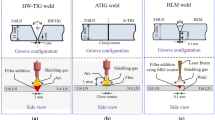Abstract
The evaluation of the creep deformation and fracture behavior of a 2.25Cr-1Mo steel base metal, a 2.25Cr-1Mo/2.25Cr-1Mo similar weld joint, and a 2.25Cr-1Mo/Alloy 800 dissimilar weld joint at 823 K over a stress range of 90 to 250 MPa has been carried out. The specimens for creep testing were taken from single-V weld pads fabricated by a shielded metal arc-welding process using 2.25Cr-1Mo steel (for similar-joint) and INCONEL 182 (for dissimilar-joint) electrodes. The weld pads were subsequently given a postweld heat treatment (PWHT) of 973 K for 1 hour. The microstructure and microhardness of the weld joints were evaluated in the as-welded, postweld heat-treated, and creep-tested conditions. The heat-affected zone (HAZ) of similar weld joint consisted of bainite in the coarse-prior-austenitic-grain (CPAG) region near the fusion line, followed by bainite in the fine-prior-austenitic-grain (FPAG) and intercritical regions merging with the unaffected base metal. In addition to the HAZ structures in the 2.25Cr-1Mo steel, the dissimilar weld joint displayed a definite INCONEL/2.25Cr-1Mo weld interface structure present either as a sharp line or as a diffuse region. A hardness trough was observed in the intercritical region of the HAZ in both weld joints, while a maxima in hardness was seen at the weld interface of the dissimilar weld joint. Both weld joints exhibited significantly lower rupture lives compared to the 2.25Cr-1Mo base metal. The dissimilar weld joint exhibited poor rupture life compared to the similar weld joint, at applied stresses lower than 130 MPa. In both weld joints, the strain distribution across the specimen gage length during creep testing varied significantly. During creep testing, localization of deformation occurred in the intercritical HAZ. In the similar weld joint, at all stress levels investigated, and in the dissimilar weld joint, at stresses ≥150 MPa, the creep failure occurred in the intercritical HAZ. The fracture occurred by transgranular mode with a large number of dimples. At stresses below 150 MPa, the failure in the dissimilar weld joint occurred in the CPAG HAZ near to the weld interface. The failure occurred by extensive intergranular creep cavity formation.
Similar content being viewed by others
References
J.D. Parker: Mater. High Temp., 1994, vol.11, pp. 25–33.
W.K.C. Jones: Weld J., 1974, vol. 53, pp. 225s-231s.
A.T. Price: Proc. Int. Conf. on “Joining Dissimilar Metals,” American Welding Society (AWS), Pittsburgh, PA, 1982, pp. 48–79.
A.K. Bhaduri, S. Venkadesan, and P. Rodriguez: Int. J. Pres. Ves. Piping, 1994, vol. 58, pp. 251–65.
R.W. Evans and B. Wilshire: in Design of High Temperature Metallic Components, R.C. Hurst, ed., Elsevier Applied Science Pub., New York, NY, 1984, pp. 89–124.
B. Nath: Proc. 4th Int. Conf. on “Welding in Nuclear Engineering,” Deutschen Verband fur Schweibtechnik, Dusseldorf, Aaken, 1982, pp. 52–56.
N.A. Mcpherson, T.N. Baker, and D.W. Miller: Metall. Mater. Trans., 1998, vol. 29A, pp. 823–32.
R.L. Klueh and J.F. King: Weld J., 1982, vol. 61, pp. 302s-311s.
K. Laha, K. Bhanu Sankara Rao, and S.L. Mannan: Mater. Sci. Eng., 1990, vol. A129, pp. 138–95.
R.G. Baker and J. Nutting: J. Iron Steel Inst., 1959, vol. 192, pp. 257–68.
C.D. Lundin, S.C. Kelly, R. Menon, and B.J. Kruse: Welding Res. Council Bull., 1986, No. 315, pp. 1–66.
M.C. Murphy and G.D. Branch: J. Iron Steel Inst., 1971, vol. 209, pp. 546–61.
E. Smith, B.E. Blanchard, and R.L. Apps: Welding of Creep Resistant Steel, The Welding Institute, Cambridge, United Kingdom, 1970, pp. 79–89.
P. Roy and T. Lauritzen: Welding J., 1986, vol. 65, pp. 45s-47s.
C.D. Lundin, J.A. Henning, R. Menon, and K.K. Khan: Report No. ORNL/Sub/81-07685/02&77, 1987, Oak Ridge National Laboratory, Oak Ridge, Tennessee.
F. Gauzzi and S. Missori: J. Mater. Sci., 1988, vol. 23, pp. 782–89.
N.F. Eaton and B.A. Glossop: Met. Constr. Br. Weld J., 1969, vol. 12, pp. 6–10.
I.J. Chilton, A.T. Price, and B. Wilshire: Met. Technol., 1984, vol. 11, pp. 383–91.
K. Laha, K.S. Chandravathi, K.B.S. Rao, and S.L. Mannan: in Heat-Resistant Materials, K. Natesan et al., eds., ASM, Gatlinburg, TN, 1995, pp. 399–404.
B.J. Cane: Proc. Int. Conf. on Welding Technology for Energy Applications, AWS and ORNL, Gatlinburg, TN, 1982, pp. 623–39.
B. Nath: in Creep and Fracture of Engineering Materials and Structures, B. Wilshire and D.R.J. Owen, eds., Pineridge Press, Swansea, U.K., 1984, pp. 827–38.
R.D. Nicholson: Met. Technol., 1982, vol. 9, pp. 305–11.
W. Zuqian and C. Xinzi: in Creep of Materials, D.A. Wood, ed., Lake Buena Vista, FL, 1992, pp. 409–15.
Author information
Authors and Affiliations
Rights and permissions
About this article
Cite this article
Laha, K., Chandravathi, K.S., Rao, K.B.S. et al. An assessment of creep deformation and fracture behavior of 2.25Cr-1Mo similar and dissimilar weld joints. Metall Mater Trans A 32, 115–124 (2001). https://doi.org/10.1007/s11661-001-0107-9
Received:
Issue Date:
DOI: https://doi.org/10.1007/s11661-001-0107-9




